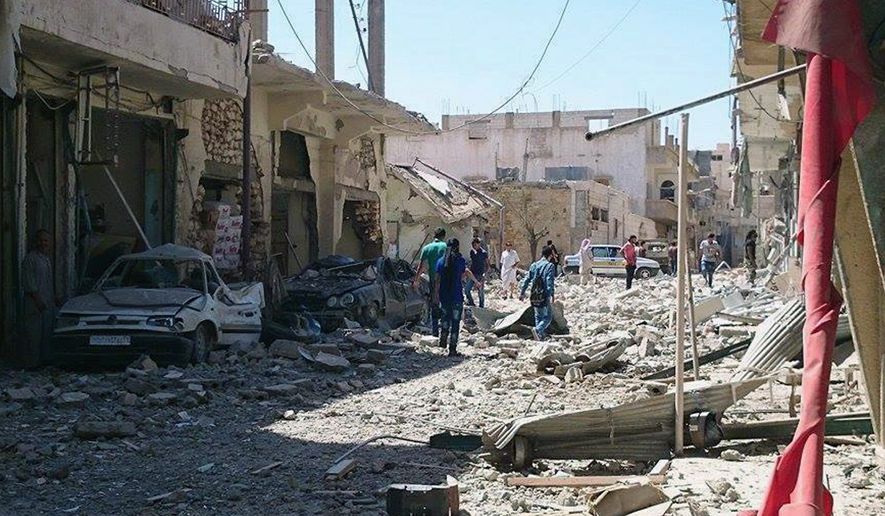President Obama’s monthlong, limited air war against the Islamic State so far has spared assassination strikes on its leaders, a policy that experts say must be reversed if the White House now plans to destroy the American-killing terrorist group.
The president is set to announce Wednesday a new strategy for attacking the Islamic State, also known as ISIS and ISIL, but the details remain sketchy. He suggested Sunday on NBC’s “Meet the Press” that in some way Islamic State leaders will be targeted.
“The strategy both for Iraq and for Syria is that we will hunt down [ISIS] members and assets wherever they are,” Mr. Obama said. “I will reserve the right to always protect the American people and go after folks who are trying to hurt us wherever they are.”
Meanwhile in Cairo, Arab League Secretary-General Nabil Elaraby appealed to the association’s 22 member-states to confront “militarily and politically” Islamic State fighters, an apparent call to arms as the U.S. launched new airstrikes against the militants in Iraq.
Last week, the Pentagon went out of its way to note that an airstrike, which Iraqi officials say killed an aide to Islamic State leader Abu Bakr al Baghdadi, did not target any individual.
The explanation underscored the limits of the current bombing policy: The U.S. only strikes Islamic State targets that threaten facilities, civilians and Americans or that block humanitarian relief.
SEE ALSO: Pressure on Obama to select, implement Islamic State plan
The president first indicated a broader campaign is about to begin when, at the NATO meeting Friday in Wales, he said his new goal is to “degrade and ultimately destroy” the Islamic State.
National security experts say to achieve that objective, Mr. Obama must endorse a campaign that includes targeted killings, such as those that have been carried out in the drone war against al Qaeda for 13 years.
“Eliminating ISIS leaders will weaken the organization through attrition while undermining recruiting efforts,” said J.D. Gordon, a retired Navy officer and former Defense Department spokesman.
Retired Army Lt. Gen. William Boykin, a Delta Force veteran and former No. 2 intelligence official at the Pentagon, said: “Killing the leadership should be a primary task right now. The ’head of the snake’ analogy applies here.”
Mr. Boykin said perhaps the administration does not want to talk about targeting leaders for fear it will drive them deeper into hiding.
On the political front, there is another problem: Mr. Obama’s liberal base has derided the U.S. drone war over Pakistan and Yemen to kill al Qaeda operatives.
Mr. Boykin added that the administration wants to avoid “a propaganda campaign that would have these leaders taunting the Obama administration for not being able to kill them.”
It is possible the administration is readying a covert plan to kill them via CIA-operated drones and missiles.
Mr. Obama has announced the beginning of a counter-Islamic State coalition of Western and Middle Eastern countries but left out details about what military tactics it would employ.
It would appear that any such campaign would have to broaden the air war inside Iraq and extend it to Syria. The Islamic State controls wide geographic areas and military bases in both countries.
Army Col. Steven Warren, a Pentagon spokesman, told The Washington Times: “The policy is that we are conducting strikes to protect U.S. personnel and facilities, support humanitarian efforts and support Iraqi forces that are acting in furtherance of these objectives. If an ISIL leader happens to be in an area where we are conducting such strikes, he will get killed along with whatever other ISIL fighters are there.”
On Friday, Defense Secretary Chuck Hagel and Secretary of State John F. Kerry issued a joint statement generally outlining what steps the emerging coalition will take to defeat the Islamic State. The statement did not mention targeting Islamic State leaders.
“We and the [NATO] ministers agreed here today that there is no time to waste in building a broad international coalition to degrade and, ultimately, to destroy the threat posed by ISIL,” Mr. Hagel and Mr. Kerry said.
They said the “international coalition to defeat ISIL” must do five things: provide military support for Iraq, stop the flow of foreign fighters to ISIL, halt the group’s funding, secure humanitarian aid and “de-legitimiz[e] ISIL’s ideology.”
Outwardly for now, the counter-Islamic State strategy is far different from the one President George W. Bush adopted to defeat al Qaeda in Iraq, the predecessor to ISIL, which was also led by al Baghdadi, known then as Abu Dura.
The U.S. spoke openly of trying to kill al Qaeda leaders, put out Internet “Wanted” posters and fused special operations and intelligence teams to hunt them down. In 2006 it killed al Baghdadi’s predecessor, Abu Musab Zarqawi, who also delighted in beheading victims.
Mr. Obama has continued the Bush policy of targeting al Qaeda leaders and affiliate leaders with assassination-by-drone in Pakistan, Yemen and Somalia. Last week the Pentagon announced that a recent airstrike killed the leader of al-Shabab, the al Qaeda-linked terrorist group in Somalia.
• This article is based in part on wire service reports.
• Rowan Scarborough can be reached at rscarborough@washingtontimes.com.




Please read our comment policy before commenting.